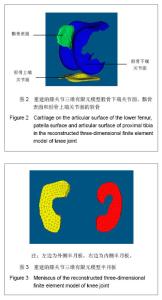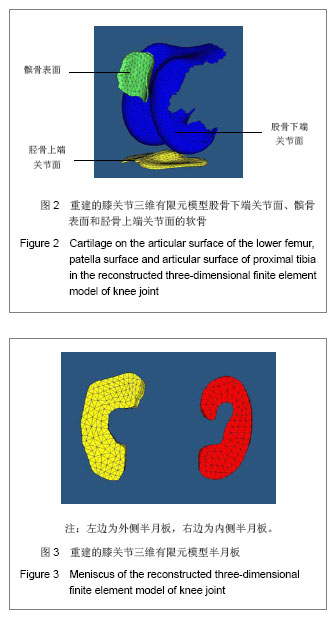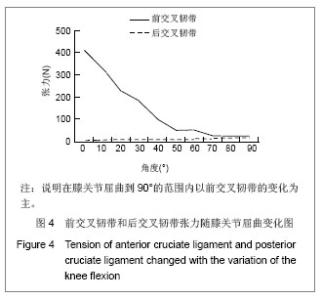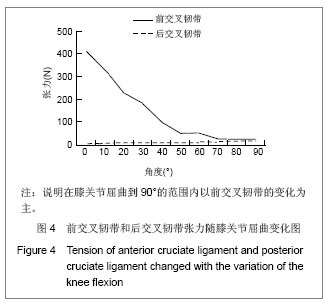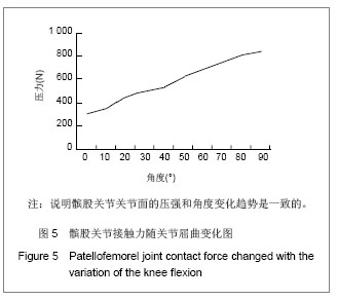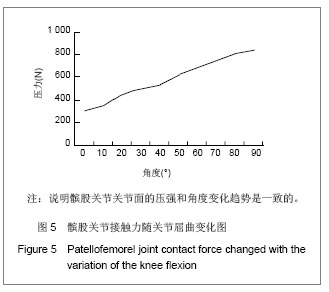Chinese Journal of Tissue Engineering Research ›› 2013, Vol. 17 ›› Issue (22): 3998-4004.doi: 10.3969/j.issn.2095-4344.2013.22.002
Previous Articles Next Articles
Mechanical analysis of knee dynamic finite element model
Hou Bo, Wang Yi, Shen Yu-hui
- Ruijin Hospital Affiliated to Shanghai Jiao Tong University, Shanghai 200020, China
-
Online:2013-05-28Published:2013-05-28 -
Contact:Wang Yi, M.D., Professor, Chief physician, Ruijin Hospital Affiliated to Shanghai Jiao Tong University, Shanghai 200020, China nealwang@hotmail.com -
About author:Hou Bo★, Master, Physician, Ruijin Hospital Affiliated to Shanghai Jiao Tong University, Shanghai 200020, China houbostrive@163.com -
Supported by:General Project of Shanghai Natural Science Foundation, No.10ZR1427800*
CLC Number:
Cite this article
Hou Bo, Wang Yi, Shen Yu-hui. Mechanical analysis of knee dynamic finite element model[J]. Chinese Journal of Tissue Engineering Research, 2013, 17(22): 3998-4004.
share this article
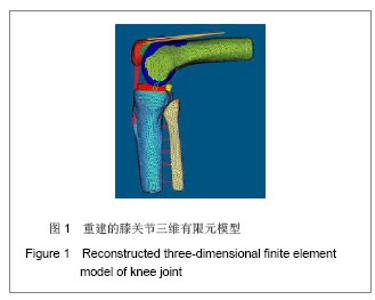
2.1 膝关节三维有限元模型建立结果 见图1-3。 根据CT图像重建膝关节的三维有限元模型,根据文献数据和实际的解剖结构重建了膝关节的软组织结构,最终生成的模型可以在图1中看到模型正位片和侧位片,模型中包含了骨性结构并且易于识别,图2中股的蓝色,绿色和黄色分别代表股骨下端关节面、髌骨表面和胫骨上端关节面的软骨,图3中的红色和黄色分别代表的是内侧半月板和外侧半月板,线状单元代表的是膝关节周围的韧带以及肌腱,模型在膝关节屈曲90°位置根据X射线建立,其中设定股骨固定,髌骨,胫骨完全自由,股四头肌的肌腱止于控制点,肌腱平行于股骨,通过控制点的上移,模拟人体坐位时膝关节的屈伸运动,根据体质量反向加载了800 N的拉力,使膝关节由屈膝90°位置逐渐伸直。 "
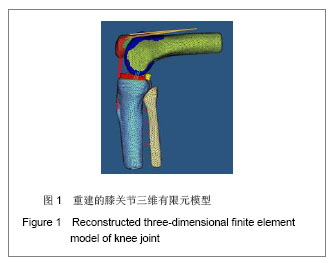
| [1]Li G,Zayontz S,DeFrate LE.Kinematics of the knee at high flexion angles.an in vitro investigation.J Orthop Res.2004;22: 90-95.[2]Reider R, Marshall JL, Ring B. Patellar tracking. Clin Orthop. 1981;157:143-148.[3]Sakai N, Luo ZP, Rand JA,et al. Quadriceps forces and patellar motion in the anatomical model of the patellofemoral joint. The Knee.1996;3:1-7. [4]Von Eisenhart-Rothe R, Siebert M, Bringmann C. New in vivo technique for determination of 3D kinematics and contact areas of the patello- femoral and tibio-femoral joint. J Biomech. 2004;37:927-934. [5]Hsu HC,Luo ZP,Rand JA,An KN.Influence of patellar thickness on patellar tracking and patellofemoral contact characteristics after total knee arthroplasty. J Arthrop 1996; 11:69-80.[6]Kwak SD, Ahmad CS, Gardner TR. Hamstrings and iliotibial band forces affect knee kinematics and contact pattern. J Orthop Res.2000;18:101-108.[7]Nagamine R, Otani T, White SE.Patellar tracking measurement in the normal knee. J Orthop Res.1995;13:115-122.[8]Hsieh Y-F, Draganich LF. Increasing quadriceps loads affect the lengths of the ligaments and the kinematics of the knee. J Biomech Eng.1998;120:750-756.[9]Hsieh Y-F, Draganich LF.Knee kinematics and ligament lengths during physiologic levels of isometric quadriceps loads.The knee.1997;4:145-154.[10]Li G, Rudy TW, Sakane M. The importance of quadriceps and hamstring muscle loading on knee kinematics and in situ forces in the ACL. J Biomech.1999;32:395-400.[11]Beynnon BD, Fleming BC, Johnson RJ. Anterior cruciate ligament strain behavior during rehabilitation exercises in vivo. Am J Sports Med.1995;23:24-34.[12]Beynnon BD, Fleming BC. Anterior cruciate ligament strain in vivo: a review of previous work. J Biomech.1998;31:519-525.[13]Draganich LF, Vahey JW.In vitro study of anterior cruciate ligament strain induced by quadriceps and hamstrings forces. J Orthop Res.1990;8:57-63.[14]Ahmed AM, Burke DL, Hyder A. Force analysis of the patellar mechanism. J Orthop Res 1987;5:69-85.[15]AeshianGA,KwakSD,Soslowsky LJ. Stereophotogrammetric method for determining in situ contact areas in diarthrodial joints, and a comparison with other methods. J Biomech 1994; 27:111-124.[16]Heegaard J, Leyvraz PF, Curnier A.The biomechanics of the human patella during passive knee flexion.J Biomech. 1995; 28(11):1265-1279.[17]Brechter JH, Powers CM. Patellofemoral joint stress during stair ascent and descent in persons with and without patellofemoral pain.Gait Posture.2002;16:115-23.[18]Fukukubayashi T, Kurosawa H. The contact area and pressure distribution pattern of the knee, a study of normal and osteoarthritic knee joints. Acta Orthop Scand 1984;51: 871-879.[19]Huberti HH, Hayes WC, Stone JL.Force ratios in the quadriceps tendon and ligamentum patellae. J Orthop Res. 1984;2:49-54.[20]Matsuda S,Ishinishi T,White SE.Patellofemoral joint after total knee arthroplasty. Effect on contact area and contact stress.J Arthroplast.1997;12:790-797.[21]Singerman R,Berilla J,Davy DT.Direct in vitro determination of the patellofemoral.contact force for normal knees.JBiomech Eng.1995;117:8-14.[22]Mesfar W, Shirazi-Adl A.Biomechanics of the knee joint in flexion under various quadriceps forces.The Knee.2005;12 424-434.[23]Goodfellow J,Hungerford DS,Zindel M.Patellofemoral joint mechanics and pathology: functional anatomy of the patellofemoral joint.J Bone Jt Surg. 1976;58-B:287–290.[24]Heegaard J, Leyvraz PF, Curnier A. The biomechanics of the human patella during passive knee flexion.J Biomech. 1995; 28:1265-1279.[25]Hirokawa S. Three-dimensional mathematical model analysis of the patellofemoral joint. J Biomech.1991;24:659-671.[26]Huberti HH, Hayes WC. Patellofemoral contact pressures: the influence of Q-angle and tendofemoral contact. J Bone Jt Surg.1984;66-A:715-724.[27]Huberti HH, Hayes WC.Contact pressures in chondromalacia patellae and the effects of capsular reconstructive procedures. J Orthop Res.1988;6:499-508.[28]Dawie J.van den Heever et al.Contact stresses in a patient-specific unicompartmental knee replacement.Clin Biomech 2011;26:159-166.[29]Peña E, Calvo B, Martínez MA, et al.A three-dimensional finite element analysis of the combined behavior of ligaments and menisci in the healthy human knee joint. J Biomech. 2006; 39:1686-1701.[30]Farrokhi S, Keyak JH, Powers CM.Individuals with patellofemoral pain exhibit greater patellofemoral joint stress:a finite element analysis study.Osteoarthritis Cartilage. 2011;19:287-e294.[31]Trent M Guessa, Ganesh Thiagarajanb, Mohammad Kiac.A subject specific multibody model of the knee with menisci.Medical Engineering & Physics.2010;32:505-515.[32]Wu ZQ,Wu YF,Su YF,Su PJ,et al. Zhonghua Shiyong Zhongxiyi Zazhi.2004;16(19):59.伍中庆,吴宇峰,苏培基,等.膝关节三维有限元模型的建立[J].中华实用中西医杂志,2004;16(19):59.[33]Wang DZ,Yu ZH,Zhou MQ,et al.Zhongguo Zuzhi Gongcheng Yanjiu yu Linchuang. 2010,14 (48):8945-8949.王大忠,余正红,周民强,等.3D膝关节模型的构建[J].中国组织工程研究与临床康复,2010,14(48):8945-8949.[34]Dong YF,Dong YH,Hu GH,et al.Linchuang Guke Zazhi. 2011; 14(2):198-203.董跃福,董英海,胡广洪,等.准确构建个体化膝关节有限元解剖模型的方法[J].临床骨科杂志,2011,14(2):198-203.[35]Yuan P,Wang WC.Zhongnan Daxue Xuebao:Yixueban. 2010; 35(1):85-89.袁平,王万春.膝关节三维有限元模型的建立及生物力学分析[J].中南大学学报:医学版,2010,35(1):85-89. |
| [1] | Xu Feng, Kang Hui, Wei Tanjun, Xi Jintao. Biomechanical analysis of different fixation methods of pedicle screws for thoracolumbar fracture [J]. Chinese Journal of Tissue Engineering Research, 2021, 25(9): 1313-1317. |
| [2] | Jiang Yong, Luo Yi, Ding Yongli, Zhou Yong, Min Li, Tang Fan, Zhang Wenli, Duan Hong, Tu Chongqi. Von Mises stress on the influence of pelvic stability by precise sacral resection and clinical validation [J]. Chinese Journal of Tissue Engineering Research, 2021, 25(9): 1318-1323. |
| [3] | Zhang Yu, Tian Shaoqi, Zeng Guobo, Hu Chuan. Risk factors for myocardial infarction following primary total joint arthroplasty [J]. Chinese Journal of Tissue Engineering Research, 2021, 25(9): 1340-1345. |
| [4] | Chen Xinmin, Li Wenbiao, Xiong Kaikai, Xiong Xiaoyan, Zheng Liqin, Li Musheng, Zheng Yongze, Lin Ziling. Type A3.3 femoral intertrochanteric fracture with augmented proximal femoral nail anti-rotation in the elderly: finite element analysis of the optimal amount of bone cement [J]. Chinese Journal of Tissue Engineering Research, 2021, 25(9): 1404-1409. |
| [5] | Zhou Jihui, Li Xinzhi, Zhou You, Huang Wei, Chen Wenyao. Multiple problems in the selection of implants for patellar fracture [J]. Chinese Journal of Tissue Engineering Research, 2021, 25(9): 1440-1445. |
| [6] | Wang Debin, Bi Zhenggang. Related problems in anatomy mechanics, injury characteristics, fixed repair and three-dimensional technology application for olecranon fracture-dislocations [J]. Chinese Journal of Tissue Engineering Research, 2021, 25(9): 1446-1451. |
| [7] | Chen Junming, Yue Chen, He Peilin, Zhang Juntao, Sun Moyuan, Liu Youwen. Hip arthroplasty versus proximal femoral nail antirotation for intertrochanteric fractures in older adults: a meta-analysis [J]. Chinese Journal of Tissue Engineering Research, 2021, 25(9): 1452-1457. |
| [8] | Huang Dengcheng, Wang Zhike, Cao Xuewei. Comparison of the short-term efficacy of extracorporeal shock wave therapy for middle-aged and elderly knee osteoarthritis: a meta-analysis [J]. Chinese Journal of Tissue Engineering Research, 2021, 25(9): 1471-1476. |
| [9] | Tang Hui, Yao Zhihao, Luo Daowen, Peng Shuanglin, Yang Shuanglin, Wang Lang, Xiao Jingang. High fat and high sugar diet combined with streptozotocin to establish a rat model of type 2 diabetic osteoporosis [J]. Chinese Journal of Tissue Engineering Research, 2021, 25(8): 1207-1211. |
| [10] | Chai Le, Lü Jianlan, Hu Jintao, Hu Huahui, Xu Qingjun, Yu Jinwei, Quan Renfu. Signal pathway variation after induction of inflammatory response in rats with acute spinal cord injury [J]. Chinese Journal of Tissue Engineering Research, 2021, 25(8): 1218-1223. |
| [11] | Zhang Xiumei, Zhai Yunkai, Zhao Jie, Zhao Meng. Research hotspots of organoid models in recent 10 years: a search in domestic and foreign databases [J]. Chinese Journal of Tissue Engineering Research, 2021, 25(8): 1249-1255. |
| [12] | Jiao Hui, Zhang Yining, Song Yuqing, Lin Yu, Wang Xiuli. Advances in research and application of breast cancer organoids [J]. Chinese Journal of Tissue Engineering Research, 2021, 25(7): 1122-1128. |
| [13] | Pei Lili, Sun Guicai, Wang Di. Salvianolic acid B inhibits oxidative damage of bone marrow mesenchymal stem cells and promotes differentiation into cardiomyocytes [J]. Chinese Journal of Tissue Engineering Research, 2021, 25(7): 1032-1036. |
| [14] | Yang Weiqiang, Ding Tong, Yang Weike, Jiang Zhengang. Combined variable stress plate internal fixation affects changes of bone histiocyte function and bone mineral density at the fractured end of goat femur [J]. Chinese Journal of Tissue Engineering Research, 2021, 25(6): 890-894. |
| [15] | Yuan Xinping, Shao Yanbo, Wu Chao, Wang Jianling, Tong Liangcheng, Li Ying. Accuracy of target bone segments in personalized differential modeling and simulation of CT scanning parameters at fracture end [J]. Chinese Journal of Tissue Engineering Research, 2021, 25(6): 912-916. |
| Viewed | ||||||
|
Full text |
|
|||||
|
Abstract |
|
|||||
